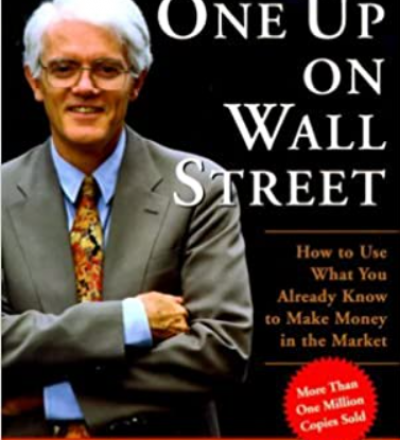One Up on Wall Street- Book Review

Premise of the book
Individual investors can beat Wall Street, and it’s easier than you think! Wall Street professionals look solely at numbers in financial statements, this means that by the time they come across a great company, it’s often too late to make substantial gains. Consider the example of McDonald’s (or Chipotle in recent years): The growth of the company is easy to catch; new McDonald’s are opening in every part of town and in every city. The average investor did not even need to look at any financial statements to figure out McDonald’s was a great investment, you could simply look around you and notice which restaurant chains are opening up.
About the author
Peter Lynch has been described as an investing legend. He has an MBA from the Wharton School of the University of Pennsylvania and spent most of his investing career at Fidelity International where he managed the Magellan Fund. As a mutual fund manager, he averaged an annual performance of 29.2% from 1977 to 1990. This performance is unparalleled in the world of mutual funds and has made Peter Lynch one of the most successful investors of all time.
Structure of the book
The book is divided in three parts:
- Understanding the fundamentals – The author sums-up the fundamentals of successful investing from investor behaviour, risk tolerance, and nature of the market.
- Understanding the different type of stocks – Peter Lynch lays out his categorisation of stocks, from slow growers (which the author refers to as sluggards) to medium growers (Stalwarts) and fast growth companies. The book then elaborates on more advanced types of stocks such as cyclicals, turnarounds, and asset plays. The author provides a comprehensive overview of his type of stocks, the pros and cons associated, and which type of investors ought to own them.
- Understanding portfolio management – The last section covers how to build a stock portfolio. When should you start buying stocks? When to sell shares? Peter Lynch lays out the criteria for each category of stocks.
Key takeaways of One Up on Wall Street
The book is jam-packed with content, I have learned a tremendous amount from this book and, believe me when I say this, I am finding it very difficult to write a short review of this masterpiece. All of the key messages are worth mentioning, that said, here are my top 15 messages from One Up On Wall Street by Peter Lynch:
The fundamentals
1. Get your priorities straight. The one investment most people get right is their home, consider buying your first home before dipping your toes in the stock market;
2. Review your budget, if you anticipate to purchase a new car, renovate your house, or pay for your children’s university tuition, make sure you have enough for these priorities before you start investing;
3. Have a good hard look at yourself. Make no mistake, over the course of your investment lifetime the market will inevitably crash at least once. Ask yourself: What will I do when the market tanks? Will I have the courage to invest even more of my hard-earned cash, or will I panic and sell my stocks? Your answer to this question is make-or-break;
4. Do your research. It’s crazy how people will spend days researching the best deals when buying a 1000€ new phone or computer, but will only spend a few minutes before buying stocks for a 1000€. Do you know why most people make money off buying their home? Because they do their research, they spend months looking at houses in different markets, scouring the neighbours, talking to the neighbours, and asking friends and family for advice. Some people even hire experts to ensure that there are no termites in the house. Do the same for your stock selection and you will get superior results.
How to value a stock?
5. Earnings are everything. As a shareholder you are entitled to a share of the business and thus to the profits. Don’t worry about the share price or the dividend, focus on the earnings generated. The higher the earnings growth, the more money you can make off the stock;
6. Study the Price to Earnings Ratio (PE). The PE ratio is one of the simplest ways to value a company; it simply measures the price of the company in relation to yearly profits. For example a slow growth company in the energy sector may have a PE ratio of 10. This means the company is selling at 10 times earnings, or in other words, if everything remains stable, you will double your money in 10 years. Avoid buying companies with extraordinarily high PE ratio (40+) unless the fundamentals justify it;
7. Study the fundamentals. A company with a PE ratio of 10 may seem cheap, but don’t neglect the balance sheet. To find out what a company is worth, simply subtract the liabilities (e.g. debt) from the assets (e.g. a factory). If the value is the company is 0, then a PE ratio of 10 will mean that you can double your money in 10 years. If the value of the company is negative (i.e. more debt than assets) buying a share of the business simply means that you, as a shareholder, is taking on the company’s debt. In this case a PE ratio of 10 may be expensive.
8. Calculate the enterprise value (EV). Sometimes the PE ratio simply doesn’t cut it and you have to look for his cousin, the EV/Earnings ratio. Simply multiply the total number of outstanding shares by the share price and you will find what the company is currently selling at today (you can find the number of shares in the financial statements). Then simply subtract any debt, add the cash, and you’ve got yourself the enterprise value (i.e. the true price of the company). Play around with this value and compare it to free cashflow, earnings, or profits, this will give you different perspectives.
9. Calculate total return. As a shareholder your returns are determined by the dividends received (cash straight to your pocket) and the earnings growth (i.e. if the earnings are growing, and the PE remains stable, the share price will increase accordingly). Some stocks (e.g. energy stocks) provide high dividends but poor earnings growth. Other stocks (e.g. tech stocks) provide very little dividends but great earnings growth. Remember both and focus on total returns rather than just dividends or growth;
Investing in the stock market
10. Don’t sell a winning stock just because you think it’s too high. Even if you’re right and the stock is overvalued, the stock won’t stay high for long, the share price will revert back to the fundamentals, and from there it will keep rising at a steady pace. Selling a winning stock to gain a 20% mark-up is counterproductive. Yes you made a quick profit, but chances are you won’t be buying back this stock any time soon (if it really is a winning stock, the stock price will keep on rising and you probably won’t buy it at a higher price than you sold it for). Remember that investing in stocks is a long-term game. Think of the poor souls who missed out on the 800% gains on Tesla because they sold for a quick 20% profits!
11. Don’t buy a mediocre company because the company is cheap. Congratulations you found a company with a PE ratio of 7 in a solid industry, but don’t get your hopes up just yet. The market isn’t blind and they may be a good reason why the stock is cheap. Even if you do your research and find that the stock is 30% undervalued, ask yourself if there are better alternatives: It may take years for the stock price to return to its fair value, and you would have settled for a 30% gain over a 5 year cycle while an index fund would have returned 50% over the same period, not every investment is worth it.
12. Don’t hold on to losing stocks. I know what you’re thinking; you’re a long term investor and you will not sell at a loss, you’ll simply wait a few months or years for the share price to return to its fair value and you will sell it then. This is a losing strategy. Focus on the fundamentals, not the share price. If the fundamentals have changed and the company is getting worse, accept the losses and move on. It’s part of the game. In general out of 10 stock pricks you can expect 2 to perform extremely well, 5 to perform as expected, and 2 to make losses. Investing is a winner’s game, you may not win every game, but you’ll win the cup.
13. Marry your stocks – Doing your research pays off, keep yourself updated on the company at least twice a year, if the fundamentals haven’t changed and it remains a good investment, hold on to it. Know your stocks well. In fact, Peter Lynch has a trick, the elevator pitch: If you can’t explain why the stock is a great investment in two minutes, you probably don’t know enough to buy it. Why do you want to buy this stock? Do you know what the company does? Why will the company keep growing? What is its competitive advantage? Why will the stock price increase?
14. Not selling a stock at a given price is the same as buying it at that price – Avoid waiting to see how the stock performs before buying or selling. Study the fundamentals and if you’re confident about the growth, hold on to it. If not, sell it and invest in an index fund instead, you owe it to your future self to make money in the stock market, don’t leave your hard-earned cash in limbo on a stock which is going nowhere.
15. It’s better to buy a great company at a fair price than a fair company at a great price – Remember the power of compounding. An expensive company with high growth is better than a cheap company with no growth. This is how you can make exponentially more gains on an stock with a PE of 30 than one with a PE of 10.
The verdict
It is no wonder that this book sold over one million copies; Peter Lynch’s 288 page work is well drafted, direct, full of valuable information, and lays out a clear plan for successful investing. One Up on Wall Street fits all audiences. New investors will appreciate the holistic view provided as it covers everything from investor behavior to why you should invest in the stock market. Advanced investors will cherish the valuable pieces of advice imparted by an investing legend. Defensive investors will be surprised to learn how investing in high-growth companies can be done with minimal risk while aggressive investors may draw lessons from Peter Lynch’s extensive experiencing in finding the treasured tenbagger.
